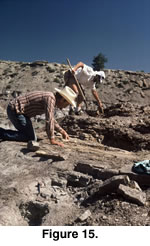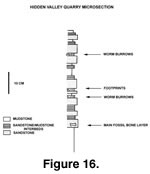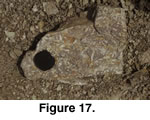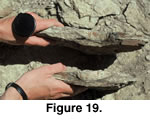JUDITH RIVER TRACKSITE
DESCRIPTION
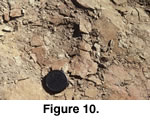 A set of 71 circular to elliptical
depressions (Figure 10,
Figure 11,
Figure 12,
Figure 13) occurs on a single bedding plane (Figure 14,
Figure 15)
approximately 60 m above the base of the Judith River Formation (Fiorillo and
Currie 1994). Based on comparisons with footprints made by modern Geochelone
elephantopus, these Cretaceous depressions are turtle tracks.
A set of 71 circular to elliptical
depressions (Figure 10,
Figure 11,
Figure 12,
Figure 13) occurs on a single bedding plane (Figure 14,
Figure 15)
approximately 60 m above the base of the Judith River Formation (Fiorillo and
Currie 1994). Based on comparisons with footprints made by modern Geochelone
elephantopus, these Cretaceous depressions are turtle tracks.
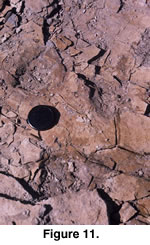 The
tracks are preserved in a finely laminated dark gray siltstone that is prone to
cracking and flaking as it dries. The bed containing the tracks is
approximately 20 to 30 mm thick and occurs within a sequence of alternating
light to medium gray, fine- to medium-grained sandstones and dark gray
siltstones (Figure 15,
Figure 16).
Beneath this unit is a layer of densely packed
macerated, carbonized plant material. This package of alternating units is
approximately 3.75 m thick. The sandstone-siltstone ratio is approximately
60:40. The alternating thin beds of sandstones and siltstones likely represent
a levee deposit.
Burrows
likely produced by worm-like organisms (Hasiotis
2002) are locally abundant in the track-bearing bed
(Figure 17).
The
tracks are preserved in a finely laminated dark gray siltstone that is prone to
cracking and flaking as it dries. The bed containing the tracks is
approximately 20 to 30 mm thick and occurs within a sequence of alternating
light to medium gray, fine- to medium-grained sandstones and dark gray
siltstones (Figure 15,
Figure 16).
Beneath this unit is a layer of densely packed
macerated, carbonized plant material. This package of alternating units is
approximately 3.75 m thick. The sandstone-siltstone ratio is approximately
60:40. The alternating thin beds of sandstones and siltstones likely represent
a levee deposit.
Burrows
likely produced by worm-like organisms (Hasiotis
2002) are locally abundant in the track-bearing bed
(Figure 17).
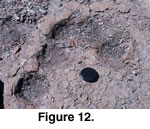 The
tracks occur as slight depressions (Figure 10,
Figure 11,
Figure 12,
Figure 13), generally elliptical or
circular in shape and only a centimeter in depth (Figure 18). None of the
tracks preserved any indication of claw marks or scratches the result of claws.
Approximately one third of the tracks had a slightly raised and rounded ridge
or lip. These lips were variable in extent, typically encircling the track but
often extending only along one side of the track. Most tracks are between 80
and 100 mm in diameter or along the major axis of each ellipse (Figure 19). The
two anomalously large diameters represent overprinting of tracks upon each
other. These two large tracks are shown in the lower right corner of the trackway map (Figure 14) and are explained below with the behavioral interpretation.
The tight, unimodal peak in the distribution of track sizes shown in
Figure 18
is evidence for a biogenic origin for these features rather than an abiogenic
origin.
The
tracks occur as slight depressions (Figure 10,
Figure 11,
Figure 12,
Figure 13), generally elliptical or
circular in shape and only a centimeter in depth (Figure 18). None of the
tracks preserved any indication of claw marks or scratches the result of claws.
Approximately one third of the tracks had a slightly raised and rounded ridge
or lip. These lips were variable in extent, typically encircling the track but
often extending only along one side of the track. Most tracks are between 80
and 100 mm in diameter or along the major axis of each ellipse (Figure 19). The
two anomalously large diameters represent overprinting of tracks upon each
other. These two large tracks are shown in the lower right corner of the trackway map (Figure 14) and are explained below with the behavioral interpretation.
The tight, unimodal peak in the distribution of track sizes shown in
Figure 18
is evidence for a biogenic origin for these features rather than an abiogenic
origin.
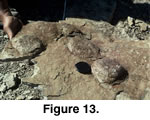 A wide trackway is a diagnostic feature for
a walking turtle (Walker 1971), yet there are no clear trackways within this
set of tracks. Therefore, definitive direction of movement is unclear. The
circular to elliptical shape of these tracks suggests that they were made by a
graviportal animal.
A wide trackway is a diagnostic feature for
a walking turtle (Walker 1971), yet there are no clear trackways within this
set of tracks. Therefore, definitive direction of movement is unclear. The
circular to elliptical shape of these tracks suggests that they were made by a
graviportal animal.
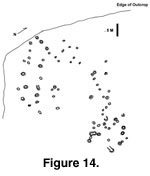 Further, comparison to modern turtle tracks suggests that
the lack of well-defined individual tracks indicates foraging behavior. Given
that turtles tend to live in proximity to one another, it is perhaps more
reasonable to suggest that multiple turtles may have been responsible for these
tracks.
Further, comparison to modern turtle tracks suggests that
the lack of well-defined individual tracks indicates foraging behavior. Given
that turtles tend to live in proximity to one another, it is perhaps more
reasonable to suggest that multiple turtles may have been responsible for these
tracks.
Although the only turtle remains
from the Hidden Valley Quarry are of a baenid, neighboring quarries have
produced other turtles (Fiorillo 1989) including Basilemys, a turtle
with a carapace length of approximately 0.75 m, thus having the appropriate
dimensions to have made tracks such as these. Aspideretes also
approaches the appropriate size, although it is not graviportal. Moreover, the
movements by modern soft-shelled turtles suggest that drag marks from the
plastron would be expected. The track maker for the Hidden Valley Quarry tracks
is most likely Basilemys.

 The
tracks are preserved in a finely laminated dark gray siltstone that is prone to
cracking and flaking as it dries. The bed containing the tracks is
approximately 20 to 30 mm thick and occurs within a sequence of alternating
light to medium gray, fine- to medium-grained sandstones and dark gray
siltstones (Figure 15,
Figure 16).
Beneath this unit is a layer of densely packed
macerated, carbonized plant material. This package of alternating units is
approximately 3.75 m thick. The sandstone-siltstone ratio is approximately
60:40. The alternating thin beds of sandstones and siltstones likely represent
a levee deposit.
Burrows
likely produced by worm-like organisms (Hasiotis
2002) are locally abundant in the track-bearing bed
(Figure 17).
The
tracks are preserved in a finely laminated dark gray siltstone that is prone to
cracking and flaking as it dries. The bed containing the tracks is
approximately 20 to 30 mm thick and occurs within a sequence of alternating
light to medium gray, fine- to medium-grained sandstones and dark gray
siltstones (Figure 15,
Figure 16).
Beneath this unit is a layer of densely packed
macerated, carbonized plant material. This package of alternating units is
approximately 3.75 m thick. The sandstone-siltstone ratio is approximately
60:40. The alternating thin beds of sandstones and siltstones likely represent
a levee deposit.
Burrows
likely produced by worm-like organisms (Hasiotis
2002) are locally abundant in the track-bearing bed
(Figure 17). A set of 71 circular to elliptical
depressions (Figure 10,
Figure 11,
Figure 12,
Figure 13) occurs on a single bedding plane (Figure 14,
Figure 15)
approximately 60 m above the base of the Judith River Formation (Fiorillo and
Currie 1994). Based on comparisons with footprints made by modern Geochelone
elephantopus, these Cretaceous depressions are turtle tracks.
A set of 71 circular to elliptical
depressions (Figure 10,
Figure 11,
Figure 12,
Figure 13) occurs on a single bedding plane (Figure 14,
Figure 15)
approximately 60 m above the base of the Judith River Formation (Fiorillo and
Currie 1994). Based on comparisons with footprints made by modern Geochelone
elephantopus, these Cretaceous depressions are turtle tracks.



